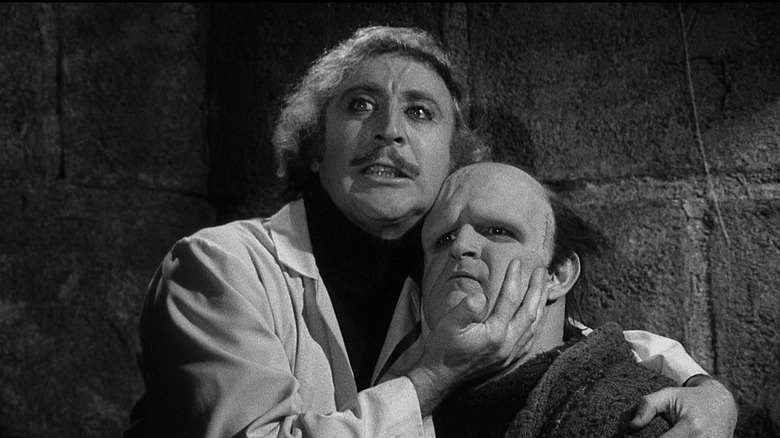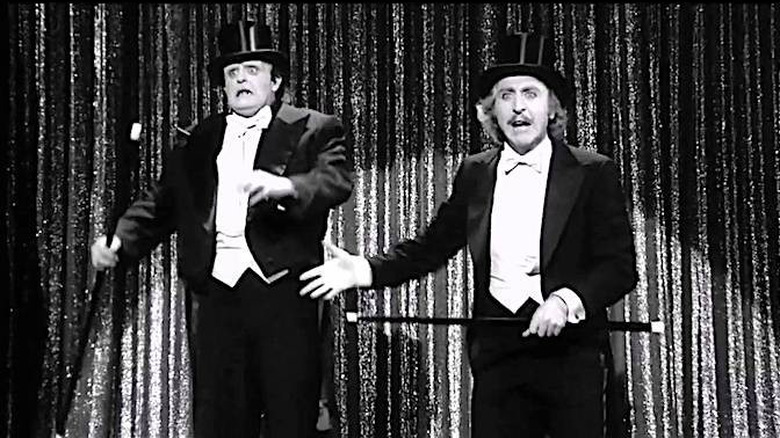Mel Brooks Wanted Gene Wilder To Cut An All-Time Classic Young Frankenstein Scene
You know him as Willy Wonka, the Waco Kid, a Frankenstein heir, and perhaps Skip Donahue. Whatever the role, Gene Wilder had a knack for burrowing into the hearts of audiences all over the world. Over several decades, the Milwaukee-born multi-hyphenate endeared scores of fans to his work in now-classic films like "The Producers," "Silver Streak," "Young Frankenstein," and "Blazing Saddles," each time lighting up the screen with natural absurdity and poignant emotional warmth.
Wilder's longtime collaboration with Mel Brooks began with the filmmaker's directorial debut, the 1967 comedy "The Producers," wherein Wilder plays neurotic accountant Leo Bloom and earned a Best Supporting Actor Oscar nomination for his performance. His most iconic role, as eccentric candyman Willy Wonka, came in 1971, just a few years before teaming up with Brooks again for his 1974 comedy-western "Blazing Saddles," filling the role of the boozy Waco Kid.
It was during the final weeks of shooting "Saddles" that Wilder and Brooks sat down "somewhere in Antelope Valley" and, armed with hot tea and biscuits, hammered out a story that would eventually become "Young Frankenstein." Speaking with Conan O'Brien on his late-night talk show, the "Stir Crazy" star talked at length about the comedy-horror and the only argument he ever had with Mel Brooks during its development:
"One night he came over, he looks at the pages and he says, 'You tap dance to Irving Berlin... in top hat and tails... with the monster?' He said, 'Are you crazy? It's frivolous.'"
"Young Frankenstein" follows Frederick Frankenstein as he claims some inherited family property in Transylvania. In addition to co-writing with Brooks, Wilder starred in the lead role of physician Frederick Frankenstein who tries to distance himself from his grandfather, the infamous mad scientist Mary Shelley wrote about.
It's pronounced 'Fronkensteen.
The "frivolous" scene that Brooks objected to was the absurd culmination of Dr. Frankenstein's inner struggle to connect with his ancestry. The doctor, who had spent the movie correcting everyone who associated him with his grandfather, had finally embraced the Frankenstein name and built upon his grandad's experiments, and had ambitions to show high society that not only did he belong there, but so did his creation (played by Peter Boyle). The scene begins relatively straight like its referential predecessors "Frankenstein," "Bride of," "Son of," etc. (the film is filled with reverent love for the source material it clowns on) but then takes a turn for the ludicrous as both scientist and creation perform a lively version of Berlin's "Puttin' on the Ritz," complete with a tap break. It all goes well until a stage light explodes, launching the creature into survival mode (compounded by the crowd throwing rotten produce at the stage). Naturally, Brooks had a hard time seeing the merit of such a scene, but Wilder tells Conan:
"I started to argue and I argued for about twenty minutes– til I was at least red in the face, I think it may have been blue– and all of a sudden [Brooks said], 'Okay, it's in.' I said, 'Why did you put me though this?' He said, 'Because I wasn't sure if it was right or not. And if you didn't argue for it, I knew it would be wrong. But if you really argued, I'd know it was right.'"
WIlder's insistence on the scene's inclusion ensured its survival to the final cut. The rest, as they say, is history.

